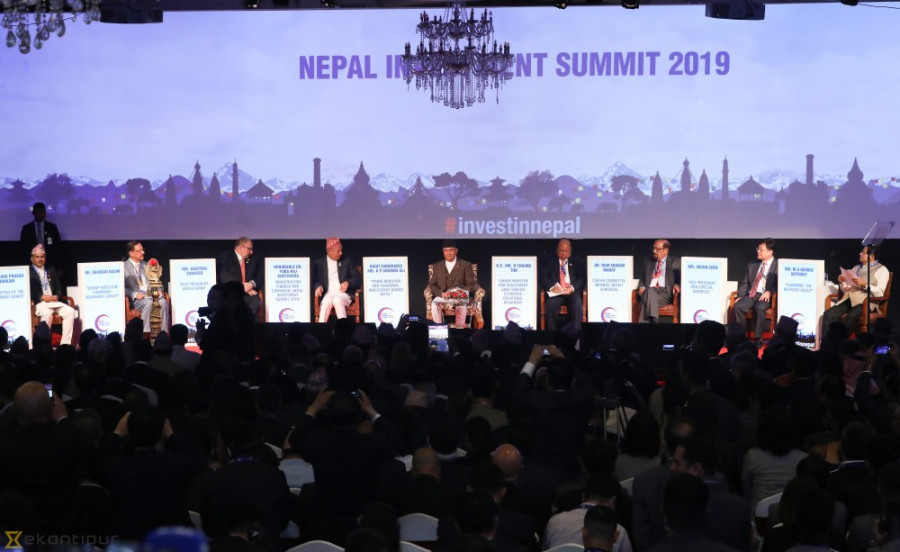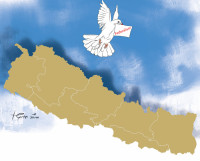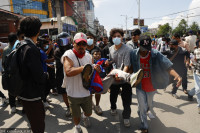Opinion
Well begun, not yet done
At the Investment Summit attended by over 600 investors representing 40 different countries, the organisers made an impassioned pitch to cast the country as an attractive investment destination.
Sailesh Tiwari
An old joke commonly told among financial economists goes like this: A professor and his friend are out on a walk when the friend spots a $20 bill on the side of the road. Just as he leans to pick it up, the professor stops him, saying, “Don’t bother, if it was real, somebody else would have picked it up already.” This joke is used to illustrate an idea that has been the cornerstone of the discipline for several decades: At any given point in time, the market knows exactly the true value of any asset and that value is reflected in its price. As such, it is not possible to make abnormal returns by trading it. Or in other words, there are no free lunches.
Foreign direct investment is, of course, vastly different from pure trades in financial assets. For one, it entails brick and mortar investments in plant, machinery and personnel, and the expected returns are contingent on the ability to sell the goods and services produced at prices higher than what would be required to recover costs. And, while investors seek good returns, they are not necessarily after free lunches. Yet, it is difficult not to see the plight of foreign direct investment in Nepal in the same light as the $20 bill in that joke: If the opportunity it represented were real, more people would be jumping on it.
Pitch-perfect remarks
The government of Nepal made a valiant attempt to upend this narrative over the weekend. At the Investment Summit attended by over 600 investors representing 40 different countries, the organisers made an impassioned pitch to cast the country as an attractive investment destination. The flurry of legislative activity that preceded the event, the pitch-perfect remarks by Prime Minister Oli and other representatives of the government, the carefully orchestrated thematic discussions and the sheer ambition contained in the 70-odd projects that were showcased during the event all reinforced one single message. A new Nepal is emerging, and it is open for business.
By all accounts, it was a highly successful event with a decent number of investment pledges and memorandums of understanding.
But, selling the potential of Nepal Inc has never been the real problem. Another equally ‘successful’ summit, organised just two years ago, had resulted in investment memorandums of understanding worth about $13.5 billion; a resounding affirmation of the opportunities Nepal offers. The fact that very little investment actually materialised suggests that the constraints to doing business in Nepal continue to impinge heavily on the realisation of these opportunities.
What the market was keen to hear this time around was whether anything material had changed on that front. Some encouraging noises were made in this regard, but the proof, as they say, will lie in the pudding. With the summit now over, hard work should begin in earnest to show that the government does indeed means business, and this will require sustained and concerted efforts.
There are several reasons to believe that this time will be different. The country is truly at an unprecedented crossroads. The ghosts of conflict and the prolonged post-conflict transition that were weighing so heavily on development prospects have been exorcised. With a new constitution in place, there is a legitimate mandate on the ruling party, which incidentally also enjoys a sizeable majority in Parliament. One cannot conjure up a better time and opportunity to push through the bold and transformative reforms, required not just to unleash the private sector, but to fundamentally alter the economic trajectory of the country.
After a lukewarm first year in office, the ruling party too should be looking to accelerate on at least beginning to lay the foundation of their economic vision for the country. Another four years may seem like a long time, but in order to be able to go to the electorate with some concrete achievements to show, they will be keenly aware of the urgency to start planting their seeds now. There is a palpable hunger for economic transformation among the Nepali people. The electoral cost of being perceived to have squandered this golden opportunity will be massive. One can only hope that this unavoidable need to deliver has entered into the political calculations.
There are reasons to be cautious as well. As earnest as they may be, strong commitments made during well-choreographed events will never be able to alter the accumulated knowledge markets have about the fundamental character of the state machinery overnight. This includes the ability to deliver a steady and stable policy environment, the efficiency of the bureaucracy to translate policies into action, and the effectiveness of the courts to uphold the rule of law in an impartial manner. One of the toughest challenges will be the management of resistance from powerful constituencies (all of whom appear to be highly connected politically) who stand to lose when foreign investors are allowed to compete on level terms.
The ability to surmount these challenges should be demonstrated—on a case by case basis if necessary—in the coming year or two. Not by picking favourites, but by implementing sweeping and comprehensive reforms. Swift, decisive and meaningful action against officials who were recently reported to have been holding contractor payments hostage to private kickbacks can be used to send a clear message to the bureaucracy to fall in line. Zero tolerance for corruption should not remain a vacuous slogan.
Finally, the projects showcased to potential investors—especially the ones related to infrastructure—expose a deeply troubling lack of an overarching vision of the country’s evolving economic geography and connectivity requirements. With international airports already in construction in Pokhara and Bhairahawa and another big one planned for Nijgadh, why do Biratnagar and Dhangadhi also require international gateways? Especially if another proposal also on the table is an electrified railway connecting Mechi and Mahakali? Have the rates of return calculations on these individual projects accounted for how their volumes might be affected by other projects in the pipeline? Likewise, within Kathmandu city, how will the planned bus rapid transit in the inner ring road interact with the ambitious multi-line metro that criss-crosses the city? Is there an optimal way to sequence these or do we sanction them simultaneously if there are any takers?
Considerations for ecology
The desire to go heavy on infrastructure investments is understandable given the gaping needs. But a lot of these planned projects will be located on crucial geological and environmental flashpoints. And because tourism will remain one of the country’s mainstays, it is important to balance connectivity needs with considerations for ecology. A well thought out master plan that takes all of these into account and lays out a long-term vision of connectivity can help weed out potential white elephants, ensure cross-project synergies and minimise the impact on the environment. Offering the entire menu to investors is neither practical nor very strategic.
Brand Nepal has more value than we often appreciate. The summit reaffirmed the considerable goodwill the country has among key partners, including important players from our fast-growing neighbourhood. If we start closing the gap between our words and actions, drawing investments for our transformative projects will not be a problem. But if the gap remains as wide as it has been in the past, then not only do we risk depleting our goodwill and credibility, but we also set ourselves for a much taller task in the future.
Tiwari tweets at @_SaileshTiwari.




 20.12°C Kathmandu
20.12°C Kathmandu


.jpg&w=200&height=120)





%20(1).jpg&w=300&height=200)

